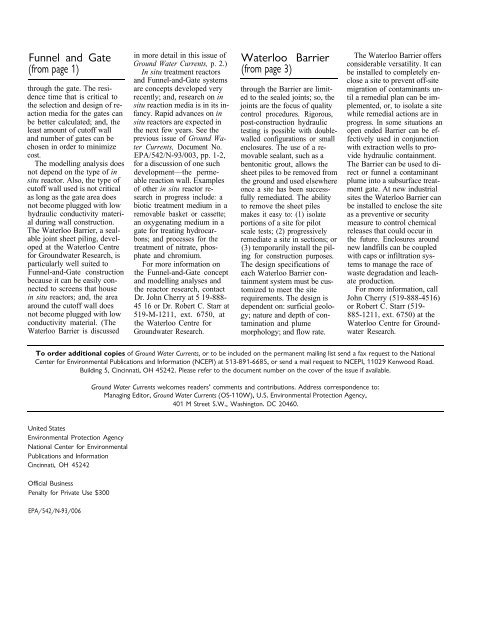Ground Water Currents June 1993 - CLU-IN
Ground Water Currents June 1993 - CLU-IN
Ground Water Currents June 1993 - CLU-IN
Create successful ePaper yourself
Turn your PDF publications into a flip-book with our unique Google optimized e-Paper software.
Funnel and Gate<br />
(from page 1)<br />
through the gate. The residence<br />
time that is critical to<br />
the selection and design of reaction<br />
media for the gates can<br />
be better calculated; and, the<br />
least amount of cutoff wall<br />
and number of gates can be<br />
chosen in order to minimize<br />
cost.<br />
The modelling analysis does<br />
not depend on the type of in<br />
situ reactor. Also, the type of<br />
cutoff wall used is not critical<br />
as long as the gate area does<br />
not become plugged with low<br />
hydraulic conductivity material<br />
during wall construction.<br />
The <strong>Water</strong>loo Barrier, a sealable<br />
joint sheet piling, developed<br />
at the <strong>Water</strong>loo Centre<br />
for <strong>Ground</strong>water Research, is<br />
particularly well suited to<br />
Funnel-and-Gate construction<br />
because it can be easily connected<br />
to screens that house<br />
in situ reactors; and, the area<br />
around the cutoff wall does<br />
not become plugged with low<br />
conductivity material. (The<br />
<strong>Water</strong>loo Barrier is discussed<br />
in more detail in this issue of<br />
<strong>Ground</strong> <strong>Water</strong> <strong>Currents</strong>, p. 2.)<br />
In situ treatment reactors<br />
and Funnel-and-Gate systems<br />
are concepts developed very<br />
recently; and, research on in<br />
situ reaction media is in its infancy.<br />
Rapid advances on in<br />
situ reactors are expected in<br />
the next few years. See the<br />
previous issue of <strong>Ground</strong> <strong>Water</strong><br />
<strong>Currents</strong>, Document No.<br />
EPA/542/N-93/003, pp. 1-2,<br />
for a discussion of one such<br />
development—the permeable<br />
reaction wall. Examples<br />
of other in situ reactor research<br />
in progress include: a<br />
biotic treatment medium in a<br />
removable basket or cassette;<br />
an oxygenating medium in a<br />
gate for treating hydrocarbons;<br />
and processes for the<br />
treatment of nitrate, phosphate<br />
and chromium.<br />
For more information on<br />
the Funnel-and-Gate concept<br />
and modelling analyses and<br />
the reactor research, contact<br />
Dr. John Cherry at 5 19-888-<br />
45 16 or Dr. Robert C. Starr at<br />
519-M-1211, ext. 6750, at<br />
the <strong>Water</strong>loo Centre for<br />
<strong>Ground</strong>water Research.<br />
<strong>Water</strong>loo Barrier<br />
(from page 3)<br />
through the Barrier are limited<br />
to the sealed joints; so, the<br />
joints are the focus of quality<br />
control procedures. Rigorous,<br />
post-construction hydraulic<br />
testing is possible with doublewalled<br />
configurations or small<br />
enclosures. The use of a removable<br />
sealant, such as a<br />
bentonitic grout, allows the<br />
sheet piles to be removed from<br />
the ground and used elsewhere<br />
once a site has been successfully<br />
remediated. The ability<br />
to remove the sheet piles<br />
makes it easy to: (1) isolate<br />
portions of a site for pilot<br />
scale tests; (2) progressively<br />
remediate a site in sections; or<br />
(3) temporarily install the piling<br />
for construction purposes.<br />
The design specifications of<br />
each <strong>Water</strong>loo Barrier containment<br />
system must be customized<br />
to meet the site<br />
requirements. The design is<br />
dependent on: surficial geology;<br />
nature and depth of contamination<br />
and plume<br />
morphology; and flow rate.<br />
The <strong>Water</strong>loo Barrier offers<br />
considerable versatility. It can<br />
be installed to completely enclose<br />
a site to prevent off-site<br />
migration of contaminants until<br />
a remedial plan can be implemented,<br />
or, to isolate a site<br />
while remedial actions are in<br />
progress. In some situations an<br />
open ended Barrier can be effectively<br />
used in conjunction<br />
with extraction wells to provide<br />
hydraulic containment.<br />
The Barrier can be used to direct<br />
or funnel a contaminant<br />
plume into a subsurface treatment<br />
gate. At new industrial<br />
sites the <strong>Water</strong>loo Barrier can<br />
be installed to enclose the site<br />
as a preventive or security<br />
measure to control chemical<br />
releases that could occur in<br />
the future. Enclosures around<br />
new landfills can be coupled<br />
with caps or infiltration systems<br />
to manage the race of<br />
waste degradation and leachate<br />
production.<br />
For more information, call<br />
John Cherry (519-888-4516)<br />
or Robert C. Starr (519-<br />
885-1211, ext. 6750) at the<br />
<strong>Water</strong>loo Centre for <strong>Ground</strong>water<br />
Research.<br />
To order additional copies of <strong>Ground</strong> <strong>Water</strong> <strong>Currents</strong>, or to be included on the permanent mailing list send a fax request to the National<br />
Center for Environmental Publications and Information (NCEPl) at 513-891-6685, or send a mail request to NCEPI, 11029 Kenwood Road.<br />
Building 5, Cincinnati, OH 45242. Please refer to the document number on the cover of the issue if available.<br />
United States<br />
Environmental Protection Agency<br />
National Center for Environmental<br />
Publications and Information<br />
Cincinnati, OH 45242<br />
Official Business<br />
Penalty for Private Use $300<br />
EPA/542/N-93/006<br />
<strong>Ground</strong> <strong>Water</strong> <strong>Currents</strong> welcomes readers’ comments and contributions. Address correspondence to:<br />
Managing Editor, <strong>Ground</strong> <strong>Water</strong> <strong>Currents</strong> (OS-110W), U.S. Environmental Protection Agency,<br />
401 M Street S.W., Washington. DC 20460.
















